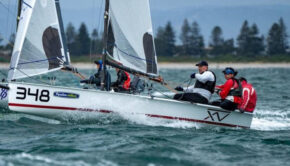Keeping Clear within the Racing Rules
Published on July 20th, 2020
The World Sailing Racing Rules Question and Answer Service is to support Race Officials, Member National Authorities and World Sailing Class Associations whereby they may submit questions through World Sailing concerning the Racing Rules of Sailing (RRS). This inquiry navigates the mingling of rules:
Definition
Keep Clear – A boat keeps clear of a right-of-way boat
(a) if the right-of-way boat can sail her course with no need to take avoiding action and,
(b) when the boats are overlapped, if the right-of-way boat can also change course in both directions without immediately making contact.
Question
When boats are overlapped, the definition Keep Clear (b) requires that the right-of-way boat can change course in both directions without immediately making contact. Rule 16.1 requires that when a right-of-way boat changes course, she shall give the other boat room to keep clear.
Similarly, in Appendix F, the definition Keep Clear includes room for a right-of-way kiteboard to move her kite in any direction without immediately making contact. Rule 16.1 requires that when a right-of-way kiteboard changes the position of her kite, she shall give the other kiteboard room to keep clear. How are these requirements compatible with each other?
Answer
The two rules are independent of each other:
The definition Keep Clear (b) is a test that decides whether a boat is keeping clear of another either under rule 11 or under rule 10 when sailing downwind on opposite tacks while rule 16.1 puts a limitation on the rights of a right-of-way boat.
• When the keep-clear boat is sailing so close that if the right-of-way changed course there would be immediate contact, the keep clear boat breaks rule 10 or 11 by not complying with the definition Keep Clear (b).
• When the keep-clear boat does not respond enough to the right-of-way boat’s change of course when she could have done so, the keep clear boat breaks rule 10 or 11 by not complying with the definition Keep Clear (a)
• When the right-of-way boat changes course in such a way that, although there is no immediate contact, it is not possible for the keep-clear boat to continue to keep clear, the right-of-way breaks rule 16.1 and the keep-clear boat shall be exonerated under rule 21 for breaking rule 10 or 11.
When making a decision, a protest committee should consider among others the prevailing conditions, the speed and the maneuverability of the boats, the distance between them and their respective actions.
This principle is the same for boats, boards and kiteboards.









 We’ll keep your information safe.
We’ll keep your information safe.